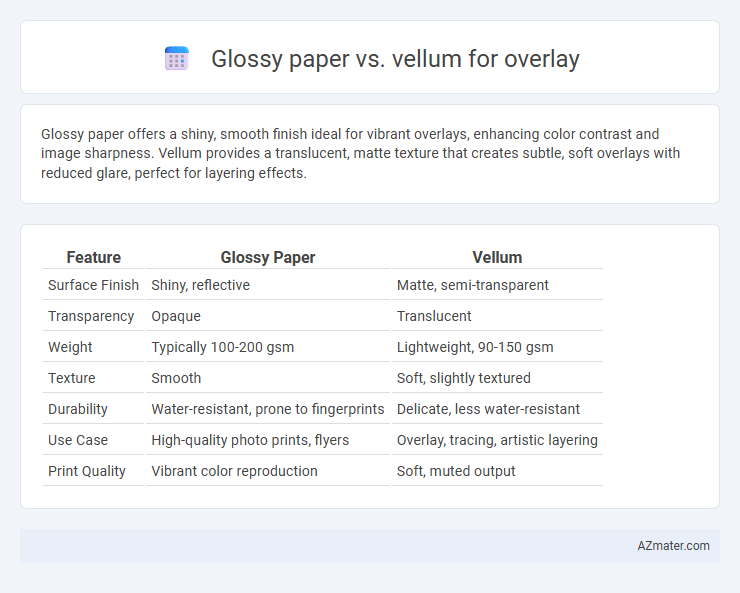Glossy paper offers a shiny, smooth finish ideal for vibrant overlays, enhancing color contrast and image sharpness. Vellum provides a translucent, matte texture that creates subtle, soft overlays with reduced glare, perfect for layering effects.
Table of Comparison
| Feature | Glossy Paper | Vellum |
|---|---|---|
| Surface Finish | Shiny, reflective | Matte, semi-transparent |
| Transparency | Opaque | Translucent |
| Weight | Typically 100-200 gsm | Lightweight, 90-150 gsm |
| Texture | Smooth | Soft, slightly textured |
| Durability | Water-resistant, prone to fingerprints | Delicate, less water-resistant |
| Use Case | High-quality photo prints, flyers | Overlay, tracing, artistic layering |
| Print Quality | Vibrant color reproduction | Soft, muted output |
Introduction: Glossy Paper vs Vellum Overlay
Glossy paper offers a shiny, reflective surface ideal for vibrant, high-contrast overlays that enhance color intensity and sharpness in printed designs. Vellum overlay provides a translucent, matte finish that allows underlying images or text to subtly show through, creating a layered, sophisticated effect. Choosing between glossy paper and vellum depends on the desired visual impact and the specific application of the overlay in print projects.
Understanding Glossy Paper: Features and Benefits
Glossy paper offers a smooth, shiny finish that enhances color vibrancy and sharpness, making it ideal for overlays requiring vivid visual impact. Its reflective surface improves contrast and detail visibility, contributing to professional, high-quality presentations and print materials. The durable coating also provides resistance to smudges and moisture, ensuring longevity and maintaining clarity in overlay applications.
Vellum Paper Explained: Characteristics and Uses
Vellum paper is a translucent, lightweight option often used for overlays in design and crafting due to its smooth texture and ability to showcase underlying images without obstruction. Its semi-transparent nature makes it ideal for layering effects, invitations, and artistic projects requiring delicate, subtle visual enhancements. Compared to glossy paper, vellum provides a matte finish that reduces glare and reflects less light, enhancing readability and creating a refined, elegant appearance.
Visual Impact: Clarity and Color Vibrancy Compared
Glossy paper offers superior visual impact with high clarity and intense color vibrancy, making images and graphics appear sharper and more vivid for overlays. Vellum provides a softer finish with muted colors and reduced glare, which creates a subtle, elegant look but less brightness and sharpness compared to glossy options. Choosing glossy paper enhances the brilliance and crispness of the overlay, ideal for presentations requiring striking visual appeal.
Texture and Feel: Tactile Differences
Glossy paper offers a smooth, reflective surface that enhances vibrant colors and sharp details, creating a sleek, polished feel ideal for eye-catching overlays. Vellum, characterized by its soft, matte texture and slight translucency, delivers a more delicate and tactile experience, lending a handcrafted, elegant touch to overlays. The choice between the two depends on desired visual impact and tactile sensation, with glossy emphasizing boldness and vellum providing subtle sophistication.
Print Quality: Ink Compatibility and Results
Glossy paper offers vibrant, sharp print quality with excellent ink compatibility, producing high contrast and saturated colors ideal for overlays that require clarity and brilliance. Vellum provides a more muted finish with a matte surface, ensuring smooth ink absorption that prevents smudging but may sacrifice some brightness and sharpness. Ink formulations designed for coated papers perform best on glossy surfaces, while vellum favors pigment-based inks for crisp, detailed results without bleeding or feathering.
Durability and Handling for Overlays
Glossy paper offers high durability with a smooth, shiny surface that resists water and smudges, making it ideal for long-lasting overlays requiring frequent handling. Vellum, known for its translucent and slightly textured finish, provides excellent rigidity but is more prone to creasing and tearing, which can affect overlay longevity. For durability and ease of handling in overlay applications, glossy paper generally outperforms vellum by maintaining a cleaner appearance and greater resistance to wear.
Suitability for Different Projects
Glossy paper offers vibrant colors and sharp details, making it ideal for photo overlays, promotional materials, and presentations requiring high visual impact. Vellum, with its translucent and matte finish, suits artistic projects, architectural overlays, and invitations where a subtle, elegant layering effect is desired. Choosing between glossy paper and vellum depends on the project's need for clarity, opacity, and the desired aesthetic effect in the final overlay.
Cost Considerations: Glossy vs Vellum
Glossy paper generally costs more than vellum due to its coated surface that enhances image vibrancy and durability, making it ideal for high-quality overlays. Vellum offers a more budget-friendly option with a matte finish and translucent quality but may lack the same level of color saturation and resistance to smudging. Choosing between glossy and vellum overlays depends largely on the balance between project budget and desired visual impact.
Choosing the Best Paper for Overlay Purposes
Glossy paper offers a shiny, reflective finish ideal for vibrant, high-contrast overlays that demand sharp image clarity and color intensity. Vellum provides a translucent, matte surface perfect for subtle layering effects and designs where readability and softness are prioritized. Selecting the best paper for overlays depends on the desired visual impact, with glossy paper enhancing brightness and vellum supporting elegance and legibility.

Infographic: Glossy paper vs Vellum for Overlay
 azmater.com
azmater.com